Safety is now about conversations, not confrontations

 One of the changes in the nature of workplace safety work happens to be the nature of conversations revolving around safety.
One of the changes in the nature of workplace safety work happens to be the nature of conversations revolving around safety.
Back in the day when safety was largely a policing job with a heavy emphasis on rules and discipline, conversations between the safety manager and an employee tended to be short and direct.
Then: "It's in the rules"
Basically the safety manager did the talking: “You know you’re supposed to be wearing safety glasses. It’s in the rules. Don’t you know the rules? I’m sending you back for more training and you’re on probation. Next time I catch you it’s time off without pay. Then it’s three strikes and you’re outta here. Got it?”
And the targeted employee might offer an excuse, but more likely didn’t put up a fight because he needed the job.
Today, safety managers are counseled to talk in a completely different manner. This came across time and again at educational sessions during last week’s National Safety Council Safety Congress & Expo.
Now: A warm and fuzzy approach
The emphasis is on probing, asking questions, all in a respectful manner, and then stepping back and listening to what the employee has to say. Feeling, values, attitudes, beliefs all can work their way into the conversation.
Old school pros must wince at this “warm and fuzzy” approach to safety.
Many safety conversations now take on the form of a coaching session. Pointing out what the employee did to put himself/herself at risk, for sure, but managers are taught to “sandwich” corrective feedback by first saying something positive about the employee’s safety actions, and closing the conversation with another positive.
And many safety pros have been prepped to answer the age-old question: “What’s in it for me if I do this safety stuff?”
Most safety pros are “people people” to begin with, which makes holding conversations easier. It’s hard imagining someone entering the safety field who is a shy introvert who would rather be left alone. That’s not in the job description of encouraging, motivating and leading employees.
Today, and especially with up and coming professionals under age 40, the job is not about intimidation and threats and throwing rulebooks at employees. It’s “seek first to understand,” as Stephen Covey said.
Looking for a reprint of this article?
From high-res PDFs to custom plaques, order your copy today!








